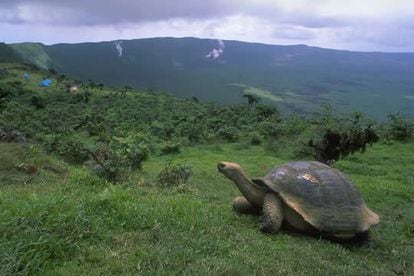A tortoise in the Galapagos Islands.
Scientific findings have become a custom in Galapagos.
The so-called Enchanted Islands launch biological discoveries from time to time confirming that they are the living laboratory of fauna and flora in which Charles Darwin drew up his theory of evolution published in 1859. The last surprise comes 162 years later, when the Ecuadorian archipelago turns 487 years since its discovery, and it revolutionizes everything that was thought about the giant tortoises that inhabit its oldest island, San Cristóbal.
It changes, in fact, the species itself.
It is not Chelonoidis chathamensis, as previously believed.
That lineage must have lived on the island at some point and become extinct because the 8.
This journey towards new biological revelation began in 2019 when the Galapagos National Park completed a census of all healthy individuals on San Cristóbal.
They took tissue and blood samples and performed genetic tests.
The results did not match baseline evidence that had been taken in 1906 by the California Academy of Sciences from tortoise skeletons collected in tunnels and caves.
In 1995 the genetic map of the turtles had begun to be drawn and in 1999 the species of each island was determined.
But the current samples don't match what was in the files.
"That was news," says Danny Rueda, director of the park, today.
"With these analyses, the conclusion was drawn that the species that is in San Cristóbal is one that has not yet been identified or has not yet been assigned a taxon."
And the other lineage so far known?
"The one from 1906 could be considered extinct, but monitoring must be carried out throughout the island to see if the two species are still alive," Rueda ventures to suggest.
The scientific team installed in the Galapagos National Park has linked the latest finding with a new tracking work on the 8,000 specimens scattered around the island.
This expectation of finding living specimens of the two lineages feeds on something more than the intuition of the Galapagos researchers.
"The field park rangers who worked in the coastal, intermediate and humid zone of the island when the 2016 census was being carried out, were able to visually notice differences in the formotypes of the turtles," admits the authority.
In plain words, despite being theoretically the same species, it did not make sense that the turtles in the coastal zone of San Cristóbal would have a different shell than those in the humid zone.
"We can no longer rule anything out," says Rueda.
"We have been doing research for 63 years and this news comes when we are supposed to have all the questions resolved."
It recalls other recent discoveries that have dismantled theories held for decades, such as the story of Fernanda, a female giant tortoise who lived as a shipwreck for almost a century on one of the most inhospitable islands and who, when found in 2019, denied that her family would have been extinguished.
Nobody had seen her until that moment because she was locked in a kind of corral formed by the lava.
After finding her, two additional expeditions were launched on the island of Fernandina to search for other companions.
No more have been found.
At the end of the year, one of the last most inaccessible areas will be combed, with the help of a helicopter.
The Galapagos are islands “still in evolution”, explains Rueda.
The archipelago is considered the jewel in the crown of Ecuador and has been declared a Natural World Heritage Site by UNESCO since 1978.
It has at least five active volcanoes in 138,000 square kilometers of marine reserve and almost 8,000 square kilometers of terrestrial park and is not without scientific headlines.
Two years ago, 30 new species of marine invertebrates were recognized in a submarine expedition to 3,400 meters.
Lobsters, corals, starfish, sponges were sampled and 30 of them were unknown until that time.
“We cannot forget June of last year when we identified a new species of fish here in Santa Cruz”, on the most inhabited island and with the most tourist dynamism.
The fish was baptized as Anisostremus Espinozai with the surname of Eduardo Espinoza, the Galapagos technician who discovered it in an investigation with the Universidad Michoacana de San Nicolás de Hidalgo in Mexico.
Thanks also to the only individual snake from Floreana -another island- that is preserved in the Science Museum in London, it was confirmed four years ago that its species became extinct.
When asking the director of the National Park about the frequency of discoveries, Rueda leaves the answer open.
Ever since science academies began to collect complete, taxidermed specimens in 1902, the Galapagos have become an inexhaustible source of scientific revelations.
You can follow MATERIA on
,
and
, or sign up here to receive
our weekly newsletter
.

